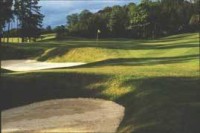The Roxburghe counters time on sand based greens
The Roxburghe counters time on sand based greens

The sand based greens on a famous Scottish Championship Golf Course are responding to treatment to counter the effects of time.
It's been seven years since the acclaimed, Dave Thomas designed, Roxburghe golf course opened near Kelso in the Scottish borders, on part of the Duke of Roxburghe's estate. Host to the Charles Church Scottish Seniors Open, and played by golfers such as Garcia, Montgomery and Sam Torrance, The Roxburghe was voted by Golf World in 2002 as 5th finest Scottish inland course, but since then, time has changed the structure of the greens.
"Sand based greens perform at a very high rate for the first 3 or 4 years and then the chemical and physical aspects of the root zone start changing," says course manager Bruce Cruickshank, who has been at Roxburghe since building finished in 1995. "They go down a bit and the grasses don't perform as well."
David Snowden of Floratine International agrees, "As the greens become more mature and the root zone more compact there's a potential danger of thatch build up, and an increase of organic matter within the soil, which will reduce gas exchange, and slow down drainage," he explains. "A young USGA spec green will drain at approx 20 inches per hour while an older one will be down to 4 or 5 inches per hour, 5 to 6 years after construction. The application of fertilisers, the demands of play and never enough aeration over the years, changes the chemical and physical balance of the root zone, and the grass does not perform to the same standard that it once did."
Bruce Cruickshank contacted Floratine through the company's Scottish distributor Greentech Sportsturf Ltd., last spring, partly on a recommendation from his brother Stuart who as course manager of Deer Park golf course at Livingston, near Edinburgh is currently working with the company, and partly because he values Analync, the soil analysis system Floratine always uses.
"To my mind Analync is more comprehensive in its analysis than most, showing not only the soil make-up but also, which elements are available to the plant and which are not," he explains. "I also feel that after the first 2 or 3 years, when we have achieved a more efficient root zone, and a generally healthier plant growth we'll be able to cut down on the number of products we apply."
Analync's findings in April and May (04) showed pH levels to be down overall, and high levels of organic matter in the three most shaded greens on the course. "Plant density and rooting could have been better," remembers David Snowden "and there were areas of located dry patch, with sections of the root zone hydrophobic."
Since then Bruce has been applying the soil penetrant Pervade followed by the wetting agent Retain to hold water in the soil. Trical 35, an immediately available source of calcium has been applied to produce stronger plant cell walls and slightly increase pH levels, and microbes have been encouraged into the root zone by an extensive aeration programme performed at various depths. As these micro organisms will gradually reduce the organic matter and break down nutrients making them more available to the plant, their presence has been further encouraged by the addition of Maxiplex, an organic humic acid, (or liquid carbon) which is an excellent food source for them. Thatch has been discouraged by scarification.
Foliar feeding includes nitrogen, calcium, magnesium and potassium, plus specific bio stimulants to improve rooting and plant density, applied in small doses every two to three weeks.
"We noticed an improvement more or less straight away," recalls Bruce Cruickshank. "The greens looked good and responded well."
"True foliar feeding improves the condition of the grass almost instantly," comments Snowden. "What we're aiming for long-term is to improve soil conditions and increase plant strength so that the grass is better equipped to fight disease. As time goes on both root zone and grass become more efficient."
"What I'm looking for in the near future is an improved putting surface and greater sward density," explains Cruickshank. "As the course will be regularly monitored with continuing soil analysis we'll be able to adjust our maintenance regime accordingly. Foliar feeding in small quantities coupled with the correct base feed means that we'll only apply what's needed."
